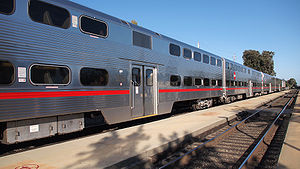Difference between revisions of "Commuter rail"
(Created page with "Commuter rail is a form of rail transit with these characteristics: * Provides regional transit in place of express bus and stops are further apart compared to light rail...") |
|||
| (One intermediate revision by the same user not shown) | |||
| Line 1: | Line 1: | ||
| + | [[File:Caltrain side.jpg|300px|right]] | ||
| + | [[File:Northstar (4013017726).jpg|300px|right]] | ||
| + | |||
Commuter rail is a form of [[rail transit]] with these characteristics: | Commuter rail is a form of [[rail transit]] with these characteristics: | ||
* Provides regional transit in place of express bus and stops are further apart compared to light rail or streetcars | * Provides regional transit in place of express bus and stops are further apart compared to light rail or streetcars | ||
| − | * Generally | + | * Generally operates on railroad corridors. |
| − | * Commuter rail uses larger, | + | * Commuter rail uses larger, faster, and heavier vehicles that can share tracks with freight and intercity passenger trains. |
| − | * Trains are operated under railroad rules and generally have a conductor onboard the train besides the engineer (train operator). | + | * Trains are operated under railroad rules (set by Federal Railroad Administration) and generally have a conductor onboard the train besides the engineer (train operator). |
| − | * Trains may be hauled by | + | * Trains may be hauled by locomotives, or have rail cars propelled by diesel engines (DMU), or electric motors (EMU) |
| − | * Service levels vary from every 5-10 minutes to every hour. Some systems may just run trains during weekday peak hours in peak directions. Service levels in general | + | * Service levels vary from every 5-10 minutes to every hour. Some systems may just run trains during weekday peak hours in peak directions. Service levels in general are lower than light rail and rapid transit. |
==Commuter rail systems== | ==Commuter rail systems== | ||
| − | {{#ask: [[Category:Commuter rail systems]] | + | {{#ask: [[Category:Commuter rail systems]] [[Category:Lead pages]] |
|format=ul | |format=ul | ||
}} | }} | ||
[[Category:Transit modes]] | [[Category:Transit modes]] | ||
Latest revision as of 21:59, 19 May 2019
Commuter rail is a form of rail transit with these characteristics:
- Provides regional transit in place of express bus and stops are further apart compared to light rail or streetcars
- Generally operates on railroad corridors.
- Commuter rail uses larger, faster, and heavier vehicles that can share tracks with freight and intercity passenger trains.
- Trains are operated under railroad rules (set by Federal Railroad Administration) and generally have a conductor onboard the train besides the engineer (train operator).
- Trains may be hauled by locomotives, or have rail cars propelled by diesel engines (DMU), or electric motors (EMU)
- Service levels vary from every 5-10 minutes to every hour. Some systems may just run trains during weekday peak hours in peak directions. Service levels in general are lower than light rail and rapid transit.


